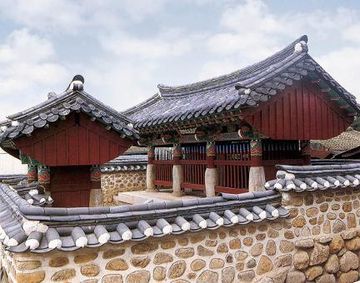나씨 삼강문
| 나씨 삼강문 Commemorative Pavilion of the Naju Na Clan |
|
 나씨 삼강문, 국가문화유산포털, 문화재청. |
|
| 대표명칭 | 나씨 삼강문 |
|---|---|
| 영문명칭 | Commemorative Pavilion of the Naju Na Clan |
| 한자 | 羅氏 三綱門 |
| 주소 | 전라남도 나주시 금남동 14-5 |
| 지정(등록) 종목 | 전라남도 문화재자료 제91호 |
| 지정(등록)일 | 1984년 2월 29일 |
| 분류 | 유적건조물/인물사건/인물기념/사우 |
| 수량/면적 | 1동 |
| 웹사이트 | 나씨 삼강문, 국가문화유산포털, 문화재청. |
|
|
|
해설문
국문
삼강문은 충신, 효자, 열녀를 기리기 위해 세운 정려(旌閭)*이다. 나씨 삼강문은 나주 나씨 나사침과 그의 아들, 며느리, 딸, 손자, 손자며느리, 손녀에 이르기까지 나주 나씨 가문의 충신, 효자, 열녀 여덟 분을 기리기 위해 세운 정려문이다. 이 삼강문은 1947년 도로를 내면서 원래의 자리에서 약간 뒤로 옮겼으며, 1974년에 고쳐 지어 오늘에 이르고 있다. 이와 똑같은 삼강문이 반남면 대안리에도 있다.
나사침(1526∼1596)은 16세 때에 어머니가 병으로 위급해지자 자신의 손가락을 잘라 그 피로 봉양하여 위기를 넘기고 어머니의 병을 낫게 하였다고 한다. 이러한 효행은 1617년 광해군 때에 편찬한 『동국신송삼강행실도』에 수록되어 있다. 그의 손자 득소(1607∼?)는 아버지 덕현이 사망하자 묘소에서 삼년상을 치렀다. 이 효성이 알려져 인조 때에 정려가 내려졌다.
나사침의 큰아들 덕명(1551∼1610)과 여섯째 아들 덕헌(1573~1640)은 기축옥사(己丑獄事)*에 연루되어 유배되었다가, 임진왜란 때에 의병을 일으키고 공을 세워 충신 정려가 내려졌다.
나사침의 넷째 아들 덕현의 처 하동 정씨와 나사침의 딸 충의위* 윤항의 처는 정유재란 때에 일본군에게 쫓기자 강물에 투신하여 순절하였고, 나사침의 둘째 아들 덕준의 딸 김집의 처는 일본군으로부터 자신을 지키기 위해 스스로 목숨을 끊었다. 모두 선조 때에 열녀 정려가 내려졌다. 또한 나사침의 손자 수소의 처 언양 김씨는 정묘호란 때에 친가가 있는 안주성에 피신해 있다가 성이 함락되자 분신자살하였다. 인조 때에 열녀 정려가 내려졌다.
- 정려(旌閭): 충신, 효자, 열녀 등을 그 동네에 정문(旌門)을 세워 표창하던 일
- 기축옥사(己丑獄事): 조선 선조 22년(1589)에 정여립(鄭汝立)의 모반을 계기로 일어난 옥사
- 충의위(忠義衛): 조선 시대 중앙군으로 오위의 충좌위에 소속되었던 양반 특수 병종
- 나덕헌은 임진왜란 때 의병이 아님. http://encykorea.aks.ac.kr/Contents/Index?contents_id=E0011312, http://www.memoryhonam.co.kr/sub10/sub02_detail.php?page=982&SeCate=&index=&searchword=&seq=212
- 나득소의 아버지는 덕현이 아니고, 덕헌임.
영문
Commemorative Pavilion of the Naju Na Clan
During the Joseon period (1392-1910), commemorative plaques or steles were bestowed by the government to honor a person’s patriotic loyalty, filial devotion, or matrimonial devotion. They were meant to be hung on red gates or in pavilions in front of the honored family’s home. This commemorative pavilion is dedicated to two loyal subjects, two filial sons, and four virtuous women of the Naju Na clan, namely the scholar and civil official Na Sa-chim (1526-1596), two of his sons, his daughter-in-law, his daughter, his grandson, his granddaughter-in-law, and his granddaughter.
Na Sa-chim became famous for helping his critically ill mother recover by cutting off his finger and feeding his blood to her. In recognition of his filial devotion, he was issued a commemoration in 1544. His eldest son Na Deok-myeong (1551-1610) mobilized a civilian army during the Japanese invasions of 1592-1598 and successfully fought the enemy, for which was bestowed the title of meritorious subject. He was posthumously commemorated as a loyal subject in 1803. Na Sa-chim’s sixth son Na Deok-heon (1573-1640) passed the state examination to become a military official in 1603. After successfully suppressing an uprising in 1624, he received the title of meritorious subject, and later visited China as an official envoy on numerous occasions, for which he was posthumously commemorated as a loyal subject in 1779.
Na Deok-heon’s son Na Deuk-so (1607-?) was known for his filial piety from an early age. When his father passed away, he completed the required multi-year mourning period, for which he was issued a commemoration for filial devotion during the reign of King Injo (r. 1623-1640).
Na Sa-chim’s daughter, his second son Na Deok-jun’s daughter, and his fourth son Na Deok-hyeon’s wife all took their own lives during the Japanese invasions while escaping the enemy. All three women were issued commemorations for matrimonial devotion during the reign of King Seonjo (r. 1567-1608). Lady Kim, the wife of Na Sa-chim’s grandson Na Su-so, also ended her own life during the Manchu invasion of 1627 when the fortress where she was hiding, Anjuseong Fortress (in today’s Anju, North Korea), was captured. A commemoration was issued to her by King Injo.
The commemorative pavilion was originally built to hold the commemorative plaque bestowed to Na Sa-chim in 1544. The plaques of his descendants were later added to the pavilion as they were issued. In 1947, due to the construction of the adjacent road, the pavilion was moved slightly backward from its original location. In 1974, it underwent a renovation.
영문 해설 내용
조선시대에는 나라에서 충신, 효자, 열녀에게 정려를 내렸으며, 정려를 받은 사람의 집 앞에 붉은 문을 세우거나 정려각을 세웠다. 이 정려문은 조선시대의 학자이자 문신이었던 나사침(1526-1596)과 그의 두 아들, 며느리, 딸, 손자, 손자며느리, 손녀에 이르기까지 나주나씨 가문의 충신 두 분과 효자 두 분 그리고 열녀 네 분을 기리기 위해 세워졌다.
나사침은 16세 때에 어머니가 병으로 위급해지자 자신의 손가락을 잘라 그 피로 봉양하여 어머니의 병을 낫게 하였다고 한다. 그의 효행이 널리 알려저 1544년에 정려를 받았다. 나사침의 큰아들 덕명(1551-1610)은 임진왜란 때 의병을 일으켜 왜적을 물리친 공으로 공신이 되었고, 1803년에 충신으로 정려를 받았다. 여섯째 아들 덕헌(1573-1640)은 1603년 무과에 급제하였고, 1624년에 일어난 반란을 진압하여 공신이 되었다. 여러 차례 청나라에 사신으로 다녀왔으며, 1779년에 충신으로 정려를 받았다.
나덕헌의 아들 득소(1607-?)는 어려서부터 효성이 지극하였다. 아버지가 사망하자 묘소에서 삼년상을 치렀고, 이 효성이 알려져 인조(재위 1623-1649) 때에 정려가 내려졌다.
나사침의 딸, 나사침의 둘째 아들 나덕준의 딸, 넷째 아들 나덕현의 부인 정씨는 임진왜란 때 적에게 쫓기자 자신을 지키기 위해 스스로 목숨을 끊었고, 모두 선조(재위 1567-1608) 때에 열녀 정려가 내려졌다. 또한 나사침의 손자 나수소의 부인 김씨는 정묘호란 때 친정이 있는 안주성(지금의 평안남도 안주시)에 피신해 있다가 성이 함락되자 자살하였다. 인조 때에 열녀 정려가 내려졌다.
이 삼강문은 1544년에 내려진 나사침의 정려를 모시기 위해 세워진 이후, 자손들의 정려가 차례로 추가되었다. 1947년 도로를 내면서 원래의 자리에서 약간 뒤로 옮겼으며, 1974년에 고쳐 지었다.